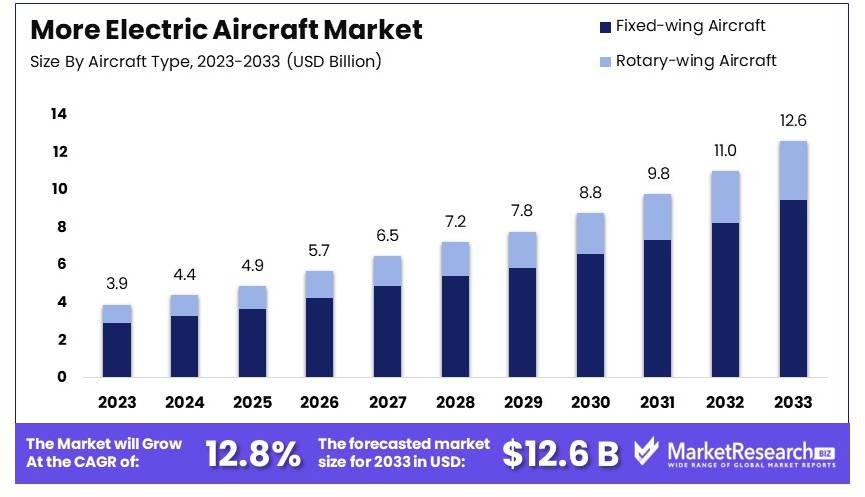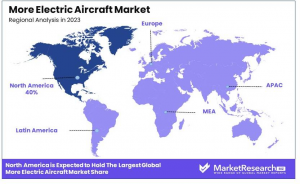
Global More Electric Aircraft Market to Grow to USD 12.6 Billion by 2033 with 12.8% CAGR

More Electric Aircraft Market Size
More Electric Aircraft Market forecasted to reach USD 12.6 Billion by 2033 from USD 3.9 Billion in 2023 at a CAGR of 12.8%
NEW YORK, NY, UNITED STATES, February 3, 2025 /EINPresswire.com/ -- Market Overview
The Global More Electric Aircraft Market size is expected to be worth around USD 12.6 Billion by 2033, from USD 3.9 Billion in 2023, growing at a CAGR of 12.8% during the forecast period from 2024 to 2033.
The More Electric Aircraft (MEA) market refers to the shift towards using electric power to replace or reduce traditional hydraulic, pneumatic, and mechanical systems in aircraft. This transition focuses on enhancing efficiency, sustainability, and reducing carbon emissions in aviation by incorporating electric technologies for key systems such as propulsion and flight controls. MEA represents a significant step toward greener and more cost-effective air travel.
The market for More Electric Aircraft is driven by the increasing demand for environmentally friendly aviation solutions and the need for lower operational costs. By replacing conventional systems with electric alternatives, MEA technologies offer benefits like reduced weight, lower maintenance, and improved fuel efficiency. As the aviation sector seeks to meet stricter environmental regulations, MEA has become a critical part of the industry's sustainability strategy. However, the integration of electric systems faces challenges, particularly in developing high-performance batteries and ensuring compatibility with existing aircraft designs.
The growth of the MEA market is supported by substantial government investment and evolving regulatory frameworks. Governments worldwide are offering funding and incentives to advance electric flight technologies as part of broader environmental initiatives. Additionally, stricter regulations regarding emissions are pushing the aviation industry to adopt cleaner technologies, further accelerating the development of MEA systems. This combination of regulatory support and technological innovation is driving the market's expansion.
For both new and established players, the MEA market presents significant opportunities. New entrants can focus on developing specialized technologies like electric propulsion systems or lightweight batteries, while established companies can diversify their portfolios by incorporating electric solutions. Strategic partnerships and investments in R&D will be key for capturing market share, positioning companies for long-term success in the growing electric aviation sector.
Curious About Market Trends? Request Your Complimentary Sample Report Today: https://marketresearch.biz/report/more-electric-aircraft-market/request-sample/
Key Takeaway
-- Market Value: The More Electric Aircraft Market was valued at USD 3.9 billion in 2023, and is expected to reach USD 12.6 billion by 2033, with a CAGR of 12.8%.
-- Aircraft Type Analysis: Fixed-wing Aircraft with 75%; Significant due to their dominant use in commercial and military aviation.
-- System Type Analysis: Power Generation held 40%; Crucial for enhancing fuel efficiency and reducing emissions.
-- Component Type Analysis: Electric Actuators dominating with 35%; Vital for improving aircraft performance and reducing maintenance costs.
-- Application Analysis: Propulsion Systems with 50%; Essential for the development of more efficient and environmentally friendly aircraft.
-- Dominant Region: North America ~40%; Leading in technological advancements and adoption of electric aircraft.
Use Cases
1. Commercial Aviation for Lower Emissions
Airlines are adopting more electric aircraft (MEA) to reduce fuel consumption and lower carbon emissions. By replacing hydraulic and pneumatic systems with electric alternatives, these planes improve energy efficiency and sustainability.
2. Urban Air Mobility and Air Taxis
Electric vertical takeoff and landing (eVTOL) aircraft are revolutionizing urban mobility. These quiet, zero-emission aircraft are ideal for short-distance commutes, airport transfers, and high-end transportation services in congested cities.
3. Military and Defense Applications
The defense sector is using electric aircraft for surveillance, reconnaissance, and transport missions. MEAs provide reduced heat signatures, making them harder to detect while offering enhanced operational efficiency.
4. Cargo and Logistics Transport
E-commerce giants and logistics companies are exploring MEAs for eco-friendly and cost-effective air freight. Electric cargo aircraft improve delivery speed while reducing the environmental impact of traditional fuel-powered planes.
5. Regional and Short-Haul Flights
Regional airlines are incorporating more electric aircraft for short-haul routes, cutting down on operational costs and fuel dependency. These planes make air travel more affordable and accessible in remote or underserved locations.
Driving Factors
1. Regulatory Pressure for Reduced Emissions: Aviation regulators worldwide are imposing stricter emission standards on aircraft to combat climate change. This regulatory pressure is pushing the industry towards more electric aircraft, which rely more on electrical systems to reduce fuel burn and emissions.
2. Technological Advancements in Electrical Systems: Innovations in electrical power systems, including more efficient batteries and generators, are enabling the development of more electric aircraft. These advancements help in reducing the weight and complexity of aircraft systems, leading to lower maintenance costs and improved performance.
3. Demand for Fuel Efficiency: Rising fuel costs are a significant concern for airlines. More electric aircraft offer enhanced fuel efficiency by optimizing electrical power use and reducing reliance on hydraulic and pneumatic systems, making them economically attractive.
4. Growth in Air Traffic: The increasing volume of global air traffic drives the need for more efficient and environmentally friendly aircraft. More electric aircraft meet these needs by offering enhanced operational efficiency and reduced environmental impact.
5. Investment in Research and Development: Significant investments in R&D by major aerospace companies and governments are propelling the development of more electric aircraft technologies. These investments facilitate continuous improvements and innovations in aircraft electrical systems.
Report Segmentation
By Aircraft Type
• Fixed-wing Aircraft
• Rotary-wing Aircraft
By System Type
• Power Generation
• Power Distribution
• Power Conversion
By Component Type
• Electric Actuators
• Electric Motors
• Electric Power Systems
• Energy Storage Devices (Batteries, Supercapacitors)
• Power Electronics
• Others
By Application
• Propulsion Systems
• Flight Control Systems
• Utility Systems (Hydraulic and Pneumatic Replacement)
• Avionics
Ready to Act on Market Opportunities? Buy Your Report Now and Get 30% off: https://marketresearch.biz/purchase-report/?report_id=48991
Regional Analysis
North America accounts for approximately 40% of the more electric aircraft market, leading in technological advancements and the adoption of electric-powered aviation solutions. The region’s strong aerospace industry, backed by significant investments in research and development from both governmental and private sectors, drives this leadership. Technological innovations in battery technology, electric motors, and power management systems are key enablers for the development of more electric aircraft.
The push towards reducing carbon emissions and noise pollution in aviation has further fueled the market, with North American companies at the forefront of designing and implementing electric systems in aircraft. The presence of major aerospace corporations and innovative startups in the region supports rapid testing and adoption of these technologies. As regulatory frameworks continue to evolve to support electric aviation and with growing environmental awareness, North America’s more electric aircraft market is poised for significant expansion in the coming years.
Growth Opportunities
Advancements in Electric Propulsion Systems
Airlines are seeking to reduce fuel consumption and emissions. Companies can invest in next-generation electric propulsion technologies, such as hybrid-electric and fully electric engines.
Lightweight and High-Efficiency Power Systems
More electric aircraft require efficient electrical systems. Innovations in lightweight batteries, supercapacitors, and advanced power electronics can drive industry growth.
Expansion in Urban Air Mobility (UAM)
The rise of air taxis and small electric aircraft for urban transport creates new opportunities. Businesses can develop electric power solutions tailored to this emerging market.
Regulatory Compliance and Certification Services
As aviation authorities create new regulations for electric aircraft, companies specializing in safety certification, testing, and compliance consulting will find growing demand.
Integration of AI and Smart Monitoring Systems
AI-driven predictive maintenance and smart monitoring can enhance aircraft efficiency and safety. Companies providing software and IoT solutions for electric aircraft can benefit from this trend.
Key Players
• Airbus SE
• The Boeing Company
• Rolls-Royce Holdings plc
• Safran S.A.
• Raytheon Technologies Corporation
• General Electric Company
• Honeywell International Inc.
• Thales Group
• Meggitt PLC
• BAE Systems plc
• United Technologies Corporation
• Elbit Systems Ltd.
• Embraer S.A.
• Leonardo S.p.A.
• Northrop Grumman Corporation
Not Sure? Request a Sample Report and See How Our Insights Can Drive Your Business: https://marketresearch.biz/report/more-electric-aircraft-market/request-sample/
Conclusion
In conclusion, the markets analyzed are all experiencing growth driven by evolving consumer preferences, technological advancements, and increasing demand for customized, high-quality products. Key trends, such as the adoption of sustainable practices, integration of smart technologies, and rising disposable incomes, are shaping the competitive landscape. While challenges such as market saturation, price sensitivity, and regional differences persist, opportunities abound for companies to capitalize on niche segments, leverage digital platforms, and innovate to meet the specific needs of their target audiences. As these industries continue to expand, businesses that adapt to changing trends, prioritize customer-centric strategies, and invest in innovation will be well-positioned for long-term success.
Related Report
Space Tourism Market: https://marketresearch.biz/report/space-tourism-market/
High Altitude Aeronautical Platform Stations Market: https://marketresearch.biz/report/high-altitude-aeronautical-platform-stations-market/
Aircraft Galley Systems Market: https://marketresearch.biz/report/aircraft-galley-systems-market/
Security Screening Systems Market: https://marketresearch.biz/report/security-screening-systems-market/
Aerospace Adhesives And Sealants Market: https://marketresearch.biz/report/aerospace-adhesives-and-sealants-market/
Lawrence John
Prudour
+91 91308 55334
Lawrence@prudour.com
Distribution channels: Consumer Goods
Legal Disclaimer:
EIN Presswire provides this news content "as is" without warranty of any kind. We do not accept any responsibility or liability for the accuracy, content, images, videos, licenses, completeness, legality, or reliability of the information contained in this article. If you have any complaints or copyright issues related to this article, kindly contact the author above.
Submit your press release

